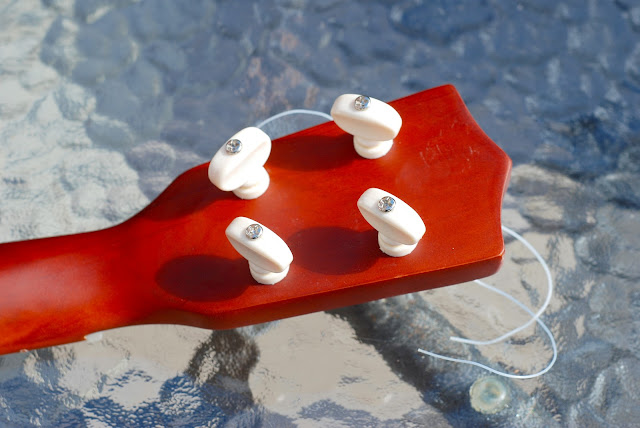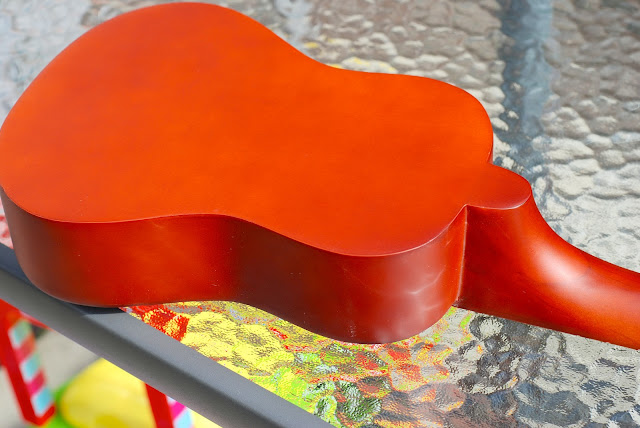Just how cheap can you get a ukulele? How cheap do you want one? I write a lot on here and elsewhere online how you should be careful at the ultra low end, price wise, as it is a total minefield as to whether you will get something that can even be tuned, let alone played.
Then I started wondering - just how cheap can you go? I have reviewed a few super-cheapies before, such as the Lidl uke by Clifton (£18), and of course the Makala Dolphin (£25) which I so regularly recommend (the latter beating the former by a long margin). Then I found myself shopping on the German music shop Thomann and came across their cheapest uke - the Harley Benton HBUK-11NT Soprano. How much? £11.29.... You read that right - just over eleven pounds... How can that even be possible? To be fair to my readers, with postage to the UK, the uke would actually be £21.29, but I was ordering something else that entitled me to free postage - as such I added it to the order for the heck of it and it therefore really did only cost me just over eleven quid. Surely at that price it would be unplayable?
 |
| The Harley Benton HBUK-11NT |
This is a soprano scale uke made from laminate wood - and when I say laminate, I mean roughly sawn plywood - as cheap as you can get. Harley Benton is kind of a trade name that Thomann give to a range of instruments that they 're-badge' so the provinence of this uke is anybody's guess. The body is traditionally soprano shaped, and finished all over in a very odd deep red satin stain cum paint - it's kind of a thin finish as if the uke has been dipped in a very watery paint and set down to dry. It's actually very similar to that finish on the Lidl uke referred to above, leading me to think it is from the same factory. Naff finish aside, it is actually applied very evenly with no drips or bubbles and is actually a better feeling and looking finish to my eyes than the Makala Dolphin!
 |
| Slot bridge |
The bridge is a slot design with a plastic, and rather thin bridge saddle, and aside from the very basic transfer soundhole rosette, that is as much bling as this uke brings to the table.
Taking a closer look at the construction and things start to look very dodgy - straight wood kerfling holding top and back to the sides, an extremely roughly finished soundhole and wood on the top that looks to be about half a centimetre thick. Looking further inside and I shudder - there are wood shavings all over the place and suspicious looking black 'bits' that I can't identify... has a mouse been sleeping in here?! I am not normally a soundhole sniffer, but I give this one a go and it smells damp. Smells like it's been sat in a wet garage for a year, perhaps adding weight to my mouse poop theory. Horrible.. The makers label itself also looks very sorry and sad - perhaps that is where the mouse slept..
 |
| Thick top, badly finished wood and 'bits'.... |
The neck is a bulky simple affair with one of the biggest neck heels I have seen. That said, it is only two pieces and finished smoothly on the back. The fingerboard seems to just be an unfinished section of the same neck wood, but actually I think it looks ok - it's simple, but has a bit of stripe to it. Again - I think it is better looking than the Dolphin and certainly better than countless Mahalos I have played. It has 12 nickel frets, quite chunky in size, but all finished nicely and no sharp fret ends - a real bonus at this price surely? Fret markers are in black plastic inlay / transfer at the 5th, 7th and 10th (no side markers).
 |
| The neck - note - only just spotted the fly on the second fret space - that doesn't come as part of the £11 price... |
Up to the nut, and that is plastic too, but set ok with nut slots that are not too deep. The headstock is
finished the same way as the rest of the uke, with a faux Martin style shape, and THE MOST uninspiring logo I have seen on a uke - a small gold transfer that they couldn't even apply straight. Tuners are frictions and as cheap as they come. The sort that either slip or bite and grate with nothing in-between. They also show signs of rust on the screws (come on... where WAS this uke stored??). That said, they are far better looking than the monstrosities they fitted to the Lidl instrument.
 |
| El-Cheapo friction tuners |
The package is finished off with a cloth gig bag and a set of rubbery slippy plastic black strings.
So all in all - as you would expect from a cheap ukulele it's a fairly sorry looking affair in many ways, but with one or two nice finishes that surprised me, particularly on the neck. The proof though would be in the playing.
Well, I didn't even bother with the black plastic strings - I knew how bad they would be, so popped a set of standard Aquilas on it. After tuning up and settling, I had some rather pleasing observations to make.
Action at both the saddle and nut were on the high side, but easily fixed, and not actually so bad as to start seriously affecting tuning and intonation. In fact, dare I say it, I have bought instruments costing hundreds of pounds with worse action and setup. No notes going sharp at the low frets, and in any case, as the saddle can be sanded, and the nut slots are not too deep from the off, both easily fixed if needed. Intonation is reasonable and starts to go a little wonky from about the 8th fret up, but as a strummer for chords at the nut, it seems fine. It's quite a heavy uke for its small size (on account of all that wood and mouse doo doo), but actually that weird satin finish is quite nice to hold and it's comfortable to play. The tuners are, as I say, a pain, but when tight will hold the strings in tune. The fretboard is comfortable on the fingers
The tone is cheap, and pretty thin, but far from the worst I have heard. It has a boxy sound comparable to many ultra cheap ukes, but it works ( I will say no more!). It is not a patch on the Dolphin for tone and volume, but stands up to the Lidl (which costs more) and beats my cheap Mahalo and Vintage quite easily. In fact, the volume is surprising, helped of course by the Aquila strings that work so well on cheap instruments.
My short summary - as a beater uke, I am really rather surprised with it, and at just over eleven pounds, absolutely staggered by it. Of course at that price, we open up all sorts of cans of worms as to the conditions the labour force who are making these have to suffer in - and that is a concern. I also need to caveat my 'surprise' with something very very important at this price point. Buying ukes for this money is like playing Russian Roulette - perhaps I got one of the few good ones in the stock - there is every chance that I could buy another with a badly set neck, bridge, frets, rendering it useless as an instrument. Equally I could get one with a terrible finish. The message is BUYER BEWARE, or rather - just get a Dolphin! I enjoyed the experiment though, and this may well now get tossed in the boot of my car for those 'dang, I forgot my ukulele' moments.
SCORES
Looks - 4.5
Fit and finish - 4.5
Sound - 4.5
Value For Money - 8.5
OVERALL - 5.5*
* note - another identical model instrument could equally be marked much lower - I genuinely think I bought a good one - or, in other words, I would be surprised if they could make one much better than the one I received for the money!



Never thought part of the setup process would include vacuuming out the interior of the uke.
ReplyDeletehello there!I will buy uku in some days.Which is better to buy?this harley benton, or this one? -->http://www.thomann.de/gr/harley_benton_hbuk12_black.htm
ReplyDeleteThis looks somewhat like the Tenayo kit I bought from Thomann. That one has the same neck, fretboard, tuners look, while the body of the kit I got is a mahogany laminate. While fun enough to put together as a learning process, the neck/fretboard that is dowelled onto the body had the dowel holes in the wrong place, so this uke will never ever play properly anyway. The neck does feel very clumsy to hold. The screws to fix the tuners were about 1 cm too short, so I had to buy new ones. I was going to make this for a fun present for my brother last Christmas but somehow the enthusiasm fizzled out and as he is no ukulele player to begin with it somehow doesn't seem right to give him this Tenayo kit monster as an entry level uke. From what I gathered, the Tenayo kit appears to be Japanese. Thanks for posting all those reviews, I have so far read through quite a number of them. Beatrix
ReplyDelete